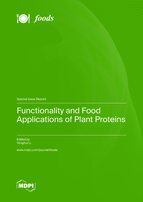Functionality and Food Applications of Plant Proteins
A special issue of Foods (ISSN 2304-8158). This special issue belongs to the section "Plant Foods".
Deadline for manuscript submissions: closed (20 December 2022) | Viewed by 63909
Special Issue Editor
Interests: bakery science and chemistry; functional grain foods; grain protein chemistry, modification, and functionality; grain-derived bioactive compounds and peptides
Special Issues, Collections and Topics in MDPI journals
Special Issue Information
Dear Colleagues,
I am inviting you to submit a review or research paper to the upcoming Special Issue — “Functionality and Food Applications of Plant Proteins”—in the journal Foods.
The demand for plant proteins continues to increase due to the growing world population, rising protein deficiency, and their versatile environmental, functional, nutritional, and health benefits. Plant proteins represent a more sustainable source to (partially) supplement costly animal-based foods, such as meat, egg, and dairy products. Soybean, wheat, and pea are the most common and available plant proteins. Other conventional, emerging, and innovative protein sources are also being explored and investigated, such as rice, corn, sorghum, oat, quinoa, potato, canola, peanut, chickpea, lentil, dry beans, hempseed, and duckweed.
Protein functional properties, such as solubility, emulsification, foaming, water holding, fat binding, viscosity and rheology, thickening, and gelling are highly associated with protein behaviors and application suitability in food items. Many factors can affect protein functionality and application, such as protein sources, protein production, intrinsic molecular structures and chemical properties, food formulation and environment, and food processing. Physical, chemical, and biochemical methods are being investigated to further enhance protein functionality. Potential applications of plan proteins include alternatives to meat, egg, and dairy products and ingredients, extenders in meat, poultry, and seafood, ingredients in bakery products, cereals, and snacks, beverages, confectionaries, and many others. Research is also ongoing to understand and address the relationships among protein chemistry and structures, functional properties, food processing, and end-use performances, which may rationally guide and accelerate the efforts in developing and utilizing plant protein ingredients.
This Special Issue focuses on the characterization, chemistry, interaction, processing, modification, functionality, and/or application of all types of plant proteins related to human foods.
Dr. Yonghui Li
Guest Editor
Manuscript Submission Information
Manuscripts should be submitted online at www.mdpi.com by registering and logging in to this website. Once you are registered, click here to go to the submission form. Manuscripts can be submitted until the deadline. All submissions that pass pre-check are peer-reviewed. Accepted papers will be published continuously in the journal (as soon as accepted) and will be listed together on the special issue website. Research articles, review articles as well as short communications are invited. For planned papers, a title and short abstract (about 100 words) can be sent to the Editorial Office for announcement on this website.
Submitted manuscripts should not have been published previously, nor be under consideration for publication elsewhere (except conference proceedings papers). All manuscripts are thoroughly refereed through a single-blind peer-review process. A guide for authors and other relevant information for submission of manuscripts is available on the Instructions for Authors page. Foods is an international peer-reviewed open access semimonthly journal published by MDPI.
Please visit the Instructions for Authors page before submitting a manuscript. The Article Processing Charge (APC) for publication in this open access journal is 2900 CHF (Swiss Francs). Submitted papers should be well formatted and use good English. Authors may use MDPI's English editing service prior to publication or during author revisions.
Keywords
- plant proteins
- animal protein alternatives
- food applications
- physicochemical properties
- techno-functional properties
- structure-function relationships
- sensory
- nutrition
- sustainability







